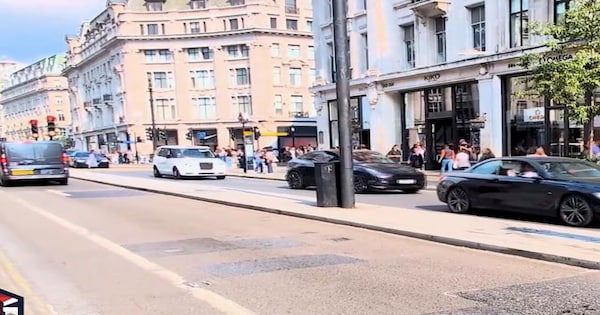How will the traffic ban impact businesses operating on Oxford Street?
London Mayor’s Bold Move: Traffic Ban on Oxford Street and Its Impact on the British Economy
The recent announcement by the London Mayor to implement a traffic ban on Oxford Street has sparked significant discussions and debates about its potential impact on the British economy. The decision, which aims to address air pollution and congestion issues, has received mixed reactions from the public, businesses, and transportation authorities.
Key Details of the Traffic Ban
The traffic ban on Oxford Street is a part of the London Mayor’s vision to create a cleaner and healthier environment in the city. The ban, which is set to be implemented as a pilot scheme, will restrict all traffic, including buses and taxis, from entering the central section of Oxford Street.
Reasons for the Ban
The primary driver behind the traffic ban is the need to reduce air pollution and improve the overall air quality in the heart of London. With Oxford Street being one of the busiest and most polluted thoroughfares in the city, the ban aims to significantly reduce emissions and create a more pedestrian-friendly environment.
Impact on Businesses
The traffic ban on Oxford Street has raised concerns among businesses operating in the area. Many retailers and restaurants fear that the ban could lead to a decline in foot traffic and ultimately impact their sales. However, proponents of the ban argue that it will create a more inviting and enjoyable atmosphere for pedestrians, potentially increasing the overall appeal of the shopping district.
Transportation Challenges
The ban also presents transportation challenges, as buses and taxis will be rerouted away from Oxford Street. This could potentially lead to increased congestion on alternative routes and disrupt existing transportation patterns. Transport for London (TfL) has been tasked with finding solutions to mitigate these challenges and ensure that commuters and visitors can still access the area efficiently.
Impact on the British Economy
The decision to implement a traffic ban on Oxford Street undoubtedly has broader implications for the British economy. As one of the leading retail and tourist destinations in the country, the changes to Oxford Street could have ripple effects across various sectors.
Economic Benefits
Proponents of the traffic ban argue that the cleaner and more pedestrian-friendly environment created by the ban could attract more visitors and shoppers to the area. This, in turn, could lead to increased spending and economic activity, benefiting retailers and local businesses in the long run.
Challenges for Businesses
However, concerns remain about the potential short-term challenges that businesses may face as a result of the ban. If foot traffic decreases initially, retailers and restaurants could experience a drop in sales, leading to financial strain. It will be crucial for businesses to adapt to the changes and explore new strategies to engage customers and drive sales during the transition period.
Case Studies
Several cities around the world have implemented similar traffic restrictions in major shopping districts, providing valuable insights into the potential impact on the economy.
Barcelona, Spain
In Barcelona’s famous La Rambla district, a pedestrianization initiative led to a notable increase in foot traffic and a revitalization of the area’s retail and hospitality sectors. Despite initial concerns, businesses ultimately benefited from the improved ambiance and increased visitor numbers.
Bogotá, Colombia
Bogotá’s implementation of car-free days in certain areas of the city resulted in decreased air pollution and a notable increase in bicycle and pedestrian traffic. Through supporting events and incentives for businesses, the city managed to maintain economic activity while achieving its environmental goals.
New York City, USA
The pedestrianization of Times Square in New York City saw a temporary drop in sales for retailers, but it ultimately led to increased foot traffic and a reinvigorated sense of community in the area. Over time, businesses adapted to the changes and capitalized on the increased visitor numbers.
Practical Tips for Businesses
Considering the potential impact of the traffic ban on Oxford Street, businesses should explore various strategies to navigate the changes and leverage the opportunities that arise.
Enhance Online Presence
With an anticipated decrease in foot traffic, businesses should focus on optimizing their online presence, including e-commerce platforms, social media, and digital marketing to reach a broader audience.
Collaborate with Local Partners
Collaborating with neighboring businesses, event organizers, and local authorities can create synergies and support joint promotional activities and events to attract visitors to the area.
Adapt the Customer Experience
Businesses can consider
The Impact of Banning Traffic on Oxford Street in London
London, the most popular city in the United Kingdom, sees a staggering number of visitors each day – at least half a million. They come for shopping, dining, and entertainment. Recently, London Mayor Sadiq Khan made an announcement that is set to change the dynamics of this bustling city; he plans to ban traffic on Oxford Street. This decision has raised questions about its potential impact on the economy, nearby shops, and local residents. Let’s delve into what this means for London City and specifically for British Indian residents living in the vicinity.
Potential Economic Effects
Banning traffic on Oxford Street could have significant economic implications for London. One major concern is its potential effect on businesses operating along this iconic street. With increased pedestrian access due to no traffic congestion, businesses may see a boost in foot traffic leading to increased sales revenue.
However, there are also concerns about how deliveries will be managed without vehicular access. Additionally, business owners worry that limited accessibility could deter customers who rely on private vehicles to reach their stores.
A Shift in Lifestyle
From a lifestyle perspective, banning traffic could lead to substantial changes for local residents living near Oxford Street. There may be concerns regarding noise reduction and improved air quality resulting from reduced traffic congestion.
Furthermore, promoting walking and cycling over driving aligns with a larger trend toward sustainable and eco-friendly practices that benefit both locals and tourists alike.
Community Impact
The move towards banning traffic on Oxford Street also holds significance for British Indian residents who call this area home. It presents an opportunity for community engagement through initiatives promoting healthier lifestyle choices such as walking or biking instead of relying solely on vehicular transport.
Additionally, reducing pollution levels can contribute towards better health outcomes within the community - something that resonates with both local authorities and citizens alike.
In Conclusion
The proposed ban on traffic along one of London’s busiest streets carries immense potential benefits but also raises valid concerns about its practicality and impact across different sectors such as commerce and resident life quality.
This shift aligns with global movements towards sustainable urban development but requires careful planning to mitigate any negative consequences.
Ultimately it remains important for stakeholders from various backgrounds including businesses, residents,and policymakers,to collaborate towards creating effective solutions that ensure a smooth transition while maximizing benefits for all involved parties.
As we look ahead to these changes,it’s essential to keep inclusivity at the forefrontand consider all perspectives when making decisions around urban infrastructure transformationSEO Keywords:London Mayor Sadiq Khan,Oxford Street,London City,British Indian Residents,Traffic Ban


